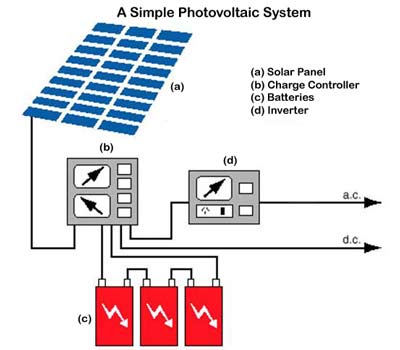|
A Photovoltaic System
A photovoltaic system (or PVS) is a system which uses solar cells (arranged into solar panels) to convert sunlight into electricity. A PVS consists of many components. These include solar cells, mechanical and electrical connections and mountings and means of regulating and/or modifying the electrical output.
Due to the low voltage of an individual solar cell, several cells are combined into photovoltaic modules (commonly called solar panels), which are then connected together into a photovoltaic array. The electricity generated can be either used directly, stored or fed into a large electricity grid. A PVS may also be combined with domestic electricity generators to create a hybrid system. A photovoltaic system is generally designed in order to ensure the highest energy yield for a given investment. Below we explore the different types of photovoltaic systems and their applications. Standalone Systems A standalone system does not have a connection to the electricity mains. Standalone systems vary in size from watches or calculators to remote buildings or spacecraft. If the load is to be supplied independently of insolation, the generated power needs to be stored using a battery. Where weight is not an issue (e.g. buildings) lead acid batteries are used. A charge controller may be incorporated in the system to avoid battery damage by excessive charging or discharging. In small devices (e.g. calculators, parking meters) only DC is consumed. In larger systems (e.g. buildings, remote water pumps) AC is usually required. To convert the DC from the modules or batteries into AC, an inverter is used. Hybrid System A hybrid system combines PV with other forms of power generation, usually a diesel generator. Biogas is also used. The other form of power generation is usually a type which is able to modulate power output as a function of demand. However more than one form of renewable energy may be used e.g. wind and solar. The photovoltaic power generation serves to reduce the consumption of non renewable fuel. Grid Connected System A grid connected system is connected to a large independent grid (typically the public electricity grid) and feeds power into the grid. Grid connected systems vary in size from residential (2-10kWp) to solar power stations (up to 10s of GWp). This is a form of decentralized electricity generation. In the case of residential or building mounted grid connected PV systems, the electricity demand of the building is met by the PV system. Power is only fed into the grid when there is an excess. The feeding of electricity into the grid requires the transformation of DC into AC by a special, grid-controlled inverter. In kW sized installations the DC side system voltage is as high as permitted (typically 1000V except US residential 600V) to limit ohmic losses. Most modules (72 crystalline silicon cells) generate about 160W at 36 volts. It is sometimes necessary or desirable to connect the modules partially in parallel rather than all in series. One set of modules connected in series is known as a 'string'. There is a growing solar DIY community and an increasing interest in environmentally friendly "green energy". Some hobbyists have endeavored to build their own PV solar systems from kits. Usually, the DIY community uses inexpensive and/or high efficiency systems (such as those with solar tracking) to generate their own power. As a result, the DIY systems often end up cheaper than their commercial counterparts. Often the system is hooked up unto the regular power grid to repay part of the investment via net metering. These systems usually generate power amount of ~2kW or less. You able to obtain plans to construct DIY systems (or at least partly DIY) and there is a growing trend toward building them for domestic requirements. The DIY photovoltaic system is now also being used both in developed countries and in developing countries, to power residences and small businesses.
Return From Photovoltaic System To Home Page |






